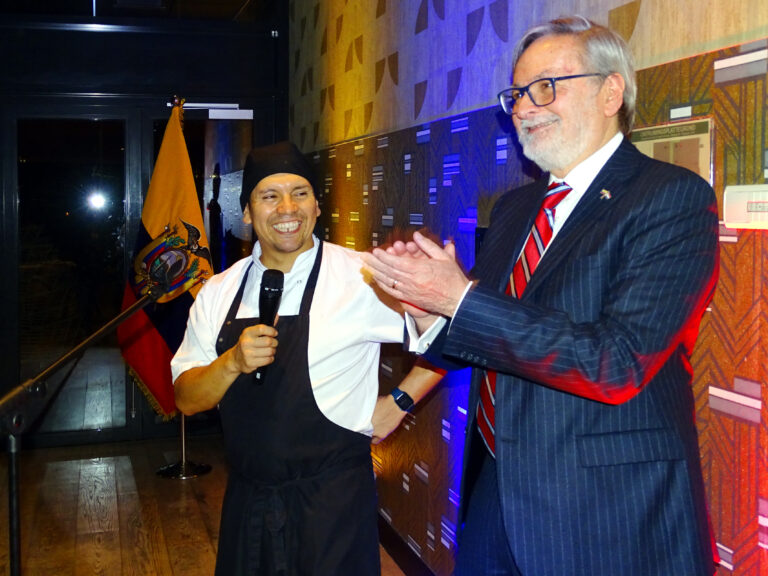By The International Institute for Middle East and Balkan Studies / IFIMES
The ongoing Russian-Ukrainian war and the evolving security situation in the Red Sea, due to attacks by the Yemeni Houthi movement on ships in this critical global trade corridor, have forced European countries to find an alternative commercial transport route that connects them with China without going through Russia, the Red Sea, or the Suez Canal.
Europe’s attention is now focused more than ever on the Middle Corridor, a combined land, sea, and rail trade route that can link China with the EU. In 2023, China was the EU’s third-largest export partner accounting for 8.8% of EU exports, while imports from China made up 20.5% of the EU’s total imports. Germany is leading European efforts to strengthen the infrastructure of this corridor to bypass the northern trade route, which connects China to Europe and passes through Russia. The three largest exporters to China from the EU are Germany (€97 billion), France (€25 billion), and the Netherlands (€22 billion)[2].
The Middle Corridor “TITR”
The Middle Corridor, known as the “Trans-Caspian International Transport Route” (TITR), is one of the three global trade corridors between China and Europe. Spanning 4,256 kilometres, it includes both land roads and railways, as well as 508 kilometres of sea routes. The corridor begins in the Chinese city of Kashgar and continues through Kyrgyzstan and Uzbekistan to the port of Türkmenbaşy on the Caspian Sea coast in Turkmenistan. From there, goods are transported in containers through Azerbaijan and Georgia to the railway station in Kars in northern Turkey, and then onward to Turkish sea ports before reaching Europe.
There are two main trade routes connecting Asia with Europe:
- The first is the sea route through the Indian Ocean, the Red Sea, the Suez Canal, and the Mediterranean Sea, which serves as the main artery for international trade. Recent tensions in the Red Sea resulted in a 50% reduction in traffic since the beginning of 2024, forcing maritime traffic to take a longer route around the African continent via the Cape of Good Hope.
- The second route is the Northern Corridor, which connects China with Europe via a railway that passes through Russia.
According to data from the Turkish Ministry of Transport and Infrastructure, the Middle Corridor is notably faster compared to the Northern Corridor, which passes through Russia. In comparison, the Northern Corridor spans around 10,000 kilometres and requires at least 15 days for transport. The Southern maritime route, approximately 20,000 kilometres long, takes between 45 and 60 days[3].
The World Bank (WB) presented key findings from its latest study on the Trans-Caspian International Transport Route (TITR), also known as the Middle Corridor, during a regional presentation in Tbilisi on 27 February 2024[4]. Cargo transport volume on the Trans-Caspian International Transport Route increased by 88% in the first nine months of 2023, reaching two million tons. This underscores the growing reliance of global trade on this corridor[5].
New geopolitical alliances in Central Asia 2024
Historically, Central Asia — encompassing Kyrgyzstan, Kazakhstan, Tajikistan, Turkmenistan, and Uzbekistan — has served as a geostrategic hub connecting Asia and Europe through infrastructure, trade, and energy networks. It remains the largest landlocked region in the world without access to global seas.
Following the dissolution of the Soviet Union, the Central Asian countries encountered significant challenges. Geopolitically, they have enhanced their infrastructure by forging stronger ties with China.
Simultaneously, these nations have aligned their long-term economic policies towards the West to attract investments and support development efforts.
U.S. policy towards the region
Historically, there was little significant Western interest in Central Asia, but the situation has now changed as the region has become a focal point of geopolitical competition among major powers: Russia, China, the United States, and the EU.
In September 2023, American President Joe Biden met for the first time with the presidents of the five Central Asian states (Kyrgyzstan, Kazakhstan, Tajikistan, Turkmenistan, and Uzbekistan) on the sidelines of the United Nations General Assembly in New York. President Biden described this meeting as a “historic moment.”[6]
The sudden U.S. withdrawal from neighbouring Afghanistan in 2021, coupled with Russian-Chinese rivalry in the region, has paved the way for new alliances in Central Asia. In essence, it is no longer a “forgotten region” but rather an emerging region preparing for a “decisive game.”
Despite challenges, leaders of Central Asian states are persistently working to institutionalize their regional alliance, particularly through regular annual meetings aimed at creating better conditions for trade and investment.
President Biden has proposed launching the C5+1 Dialogue on critical minerals to develop and harness the abundant mineral wealth of Central Asia. Kazakhstan looks to the United States for support in establishing a UN Regional Center for Sustainable Development Goals. Meanwhile, Kyrgyzstan is actively encouraging international investors to invest in its hydropower sector.
Japan: A new player in Central Asia
Interestingly, Japan has recently embarked on efforts to engage in the geopolitical game of courting Central Asian countries. While Tokyo and Central Asian nations have shared historical ties since ancient times, Japan’s recent interest in the region appears to be growing.
Prime Minister Fumio Kishida plans to visit Central Asia in August 2024 and participate in the inaugural summit with the leaders of the five-country group (Kyrgyzstan, Kazakhstan, Tajikistan, Turkmenistan, and Uzbekistan). Meanwhile, Kyrgyz President Sadyr Japarov visited Tokyo on 2 November 2023, aiming to reduce the dependency of Central Asian countries on Russia and China. During a joint press conference, the Japanese prime minister emphasized the significance of strengthening cooperation with Central Asia, particularly in sustainable development, infrastructure support, and human resource development. Looking ahead, Japan could potentially assist in developing the Caspian Sea transport route, and Tokyo may also actively participate in projects involving renewable energy and decarbonization in Central Asian countries[7].
EU policy towards Central Asia
President of the European Council, Charles Michel, visited Kyrgyzstan on 3 June 2023, to participate in the Second Summit between the European Union and Central Asia, a region currently experiencing intense competition among major powers. The event took place just two weeks after President Xi Jinping’s summit with the leaders of the five Central Asian states on 18 May 2023. China is consolidating its economic dominance in this traditionally Russian-influenced region, which is pivotal for China’s Belt and Road Initiative (BRI), valued at one trillion dollars.
The Russo-Ukrainian war has given new impetus to relations between Central Asia and the European Union. With Moscow preoccupied with the conflict and ensuing sanctions, leaders of Central Asian states are taking steps to diversify their partnerships and reduce dependency on Russia and China, while simultaneously enhancing relations with Turkey, India, Japan, UAE, and others.
The European Union is the largest donor to the region, providing 1.1 billion euros in aid between 2014 and 2020. Furthermore, the EU stands as the leading investment partner in Central Asia, representing 42% of total investments, significantly ahead of the United States (14.2%), Russia (6%), and China (3.7%).
In early 2023, the EU threatened to impose additional sanctions on countries accused of aiding Russia in circumventing Western sanctions, including Central Asian states. This EU move aims to mitigate the impact of sanctions against Russia, which could indirectly affect Central Asian countries and potentially push them closer into Moscow’s embrace. Despite the region’s declared commitment to pursuing a multilateral foreign policy, these nations maintain close ties with Russia due to military, economic alliances, and cultural connections. Meanwhile, China has taken a more active role in the region by approving significant loans to finance the “New Silk Routes” massive infrastructure projects.
Political systems in Central Asia remain the focus of Western non-governmental organizations (NGOs), which characterize them as authoritarian. However, the official policy of the EU is not influenced by such considerations. The truth is that these countries have strong central administrations with significant presidential powers, similar to many Western states such as the US, France, and others.
President Japarov enhanced EU-Kyrgyzstan partnership
Five years after concluding negotiations and initialling the draft Enhanced Partnership and Cooperation Agreement (EPCA), Kyrgyzstan and the European Union signed the agreement in Brussels during the working visit of Kyrgyz President Sadyr Japarov on 25 June 2024. The ceremony took place in the presence of President Japarov and President of the European Council Charles Michel[8].
EPCA replaces the earlier Partnership and Cooperation Agreement (PCA) from 1999, which had previously formed the basis of EU-Kyrgyzstan relations.
High Representative of the European Union for Foreign Affairs and Security Policy and Vice-President of the European Commission, Josep Borrell, stated: “We are happy to count the Kyrgyz Republic amongst our close partners.” He characterized the EPCA as a demonstration of the EU’s “steadfast commitment to strengthening and deepening our bilateral relations based on shared values and common interests in all areas of mutual benefit, reflecting new geopolitical and economic realities.” The European External Action Service (EEAS) later released a statement quoting Borrell, emphasizing that the EU is “pleased to count the Kyrgyz Republic amongst our close partners.”
The EEAS highlighted key areas of cooperation including trade, investment, sustainable development, connectivity, research, innovation, education, environmental protection, climate change, as well as governance, human rights, and civil society.
The EU anticipates that this agreement will facilitate “strengthening cooperation in foreign and security policy, including conflict prevention and crisis management, risk reduction, cybersecurity, regional stability, disarmament, non-proliferation, arms control, and export control.”[9]
Analysts highlight the significance of advancing EU-Kyrgyzstan relations, largely attributed to President Sadyr Japarov’s efforts and commitment to improve ties with the European Union. The signed EPCA agreement serves as the formal foundation for enhancing relations across all sectors.
Ljubljana/Bruxelles/Bishkek, 9 August 2024
Footnotes:
[1] IFIMES – International Institute for Middle East and Balkan Studies, based in Ljubljana, Slovenia, has a special consultative status with the United Nations Economic and Social Council ECOSOC/UN in New York since 2018, and it is the publisher of the international scientific journal “European Perspectives.”
[2] China – EU – International trade in goods statistics. Available at: https://ec.europa.eu/eurostat/statistics-explained/index.php?title=China-EU_-_international_trade_in_goods_statistics
[3] Türkiye’s Multilateral Transportation Policy. Available at: www.mfa.gov.tr/turkiye_s-multilateral-transportation-policy.en.mfa .
[4] World Bank Presents Key Findings of Latest Study on Middle Corridor in Tbilisi. Available at: https://astanatimes.com/2024/03/world-bank-presents-key-findings-of-latest-study-on-middle-corridor-in-tbilisi/
[5] Cargo Transportation Along Middle Corridor Soars 88%, Reaches 2 Million Tons in 2023
[6] First Central Asia – USA summit in New York – Agenda and Initiatives. Available at: www.newscentralasia.net/2023/09/20/first-central-asia-usa-summit-in-new-york-agenda-and-initiatives/
https://astanatimes.com/2023/12/cargo-transportation-along-middle-corridor-soars-88-reaches-2-million-tons-in-2023/
[7] Japan looks to wean Kyrgyzstan off reliance on China, Russia. Available at: https://asia.nikkei.com/Politics/International-relations/Japan-looks-to-wean-Kyrgyzstan-off-reliance-on-China-Russia
[8] Factsheet on Enhanced Partnership and Cooperation Agreement between the EU and Kyrgyz Republic, Available at: www.eeas.europa.eu/eeas/factsheet-enhanced-partnership-and-cooperation-agreement-between-eu-and-kyrgyz-republic_en
[9] Kyrgyzstan, EU Sign Enhanced Partnership and Cooperation Agreement. Available at: https://thediplomat.com/2024/06/kyrgyzstan-eu-sign-enhanced-partnership-and-cooperation-agreement/
















